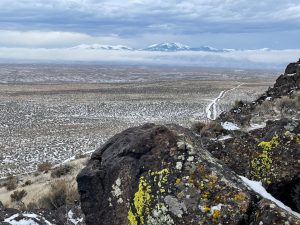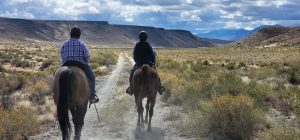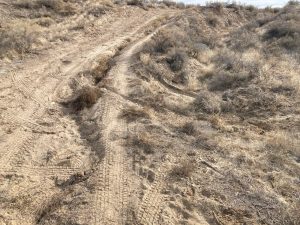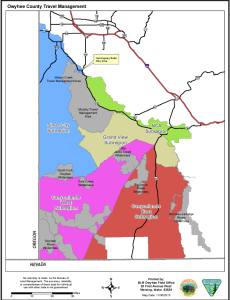BLM at risk of prioritizing OHVs over eagles in the Morley Nelson Snake River Birds of Prey National Conservation Area
Congress designated the Snake River Birds of Prey National Conservation Area in 1993 to protect the largest and densest population of breeding birds of prey in the United States, and to protect critical nesting areas and the habitat these raptors and their prey rely on. According to the BLM, more than 700 pairs of prairie falcons, eagles, hawks, and owls nest on the cliffs and nearby areas. This area consists of spectacular canyons along 81 miles of the Snake River, sagebrush steppe plains, volcanic buttes, and sand washes. The area was renamed for Idaho’s famous raptor advocate and visionary conservationist Morley Nelson in 2009, well-recounted in the Feathers and Frontiers video. The Birds of Prey NCA Partnership also has a great podcast series all about this National Conservation Area. Now, the BLM is developing a much-needed Travel Management Plan for the 112,087-acre portion of the NCA south of the Snake River.
Balancing Eagles and Access
The Owyhees have plenty of room for hikers, equestrians, mountain bikers, dirt bikers, OHV enthusiasts and other recreationists, but not every use can happen in every place. The National Conservation Area was designated specifically to provide for the conservation, protection, and enhancement of raptor populations and habitats. Access for people to admire and study raptors is an important component of this National Conservation Area, but too much human disturbance at the wrong times can cause raptors to abandon their nests and fragment their habitat.The BLM is considering the following alternatives for the National Conservation Area Travel Management Plan: Alternative A which retains all user-created routes; Alternative B which best protects raptors and their habitat by closing excessive routes; Alternative C which converts some motorized routes to equestrian and hiking trails; and Alternative D, the maximum motorized alternative, which would authorize motorized routes at densities that would impair the conservation goals of the National Conservation Area. Alternative B is the most protective for raptors, their prey, and their habitat. The boundaries of Snake River Birds of Prey National Conservation Area were based on years of scientific studies of which areas raptors such as prairie falcons utilize for foraging. This is one of the few Congressionally designated areas where the boundaries are based on the specific needs of the raptors, their prey, and the habitat they rely on.
Alternative B is the most protective for raptors, their prey, and their habitat. The boundaries of Snake River Birds of Prey National Conservation Area were based on years of scientific studies of which areas raptors such as prairie falcons utilize for foraging. This is one of the few Congressionally designated areas where the boundaries are based on the specific needs of the raptors, their prey, and the habitat they rely on. Alternative C would set aside 31 miles of non-motorized trails while still authorizing 203 miles of motorized trails. Providing a diverse variety of recreational opportunities is most consistent with the purposes of the National Conservation Area.
Alternative C would set aside 31 miles of non-motorized trails while still authorizing 203 miles of motorized trails. Providing a diverse variety of recreational opportunities is most consistent with the purposes of the National Conservation Area.  Alternative D, the alternative with the maximum motorized route density, would continue to adversely affect golden eagles, important prey species, and their habitat. Plus, instead of balancing different types of recreation, Alternative D would prioritize 341 miles of trails for motorized recreational vehicles and dedicate less than one mile of non-mechanized trails for hikers and equestrians.
Alternative D, the alternative with the maximum motorized route density, would continue to adversely affect golden eagles, important prey species, and their habitat. Plus, instead of balancing different types of recreation, Alternative D would prioritize 341 miles of trails for motorized recreational vehicles and dedicate less than one mile of non-mechanized trails for hikers and equestrians. ICL and other public lands and wildlife advocates are asking the BLM to select a combination of Alternatives B and C, which would:
ICL and other public lands and wildlife advocates are asking the BLM to select a combination of Alternatives B and C, which would:
- prioritize the protection of raptors and their habitat
- secure key motorized access routes for the public to enjoy raptors without disturbing them
- designate a network of equestrian and hiking trails consistent with the NCA’s conservation mandate
- maintain these routes into the future
- protect habitat from illegal off road use
- restore degraded habitat by rehabilitating high risk, user-created routes
The BLM recently selected the “maximum motorized alternative” for the entirety of the Canyonlands East and Canyonlands West Travel Planning Areas, authorizing 2,115 miles of routes as motorized and just 5 miles as non-motorized trails across over 1,340,000 acres of public lands. Tell the BLM to not repeat the same mistakes here for the Snake River Birds of Prey National Conservation Area.  Please tell the BLM that a combination of Alternatives B and C of the NCA South Travel Management Plan would do the best job of protecting raptors and securing public access for everyone who thrills at their flights in the canyon.The BLM is taking public comments through January 12, 2024. Speak up for Idaho's birds of prey and this special place by taking action below!TAKE ACTIONThe Silver City and Grand View Travel Management Plans will be out for public comment next. Please sign up here to be alerted when these next travel plans come out and speak up for your favorite hiking trails and wildlife areas.
Please tell the BLM that a combination of Alternatives B and C of the NCA South Travel Management Plan would do the best job of protecting raptors and securing public access for everyone who thrills at their flights in the canyon.The BLM is taking public comments through January 12, 2024. Speak up for Idaho's birds of prey and this special place by taking action below!TAKE ACTIONThe Silver City and Grand View Travel Management Plans will be out for public comment next. Please sign up here to be alerted when these next travel plans come out and speak up for your favorite hiking trails and wildlife areas.

